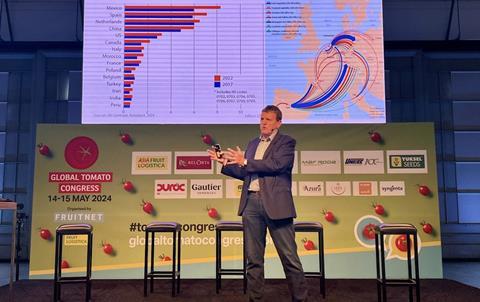The two-day event, taking place in The Hague, opened with an overview of the global tomato business and a focus on consumer preferences

Fruitnet’s annual Global Tomato Congress welcomed more than 200 delegates to the Fokker Terminal in The Hague today (14 May) for a deep-dive into the latest insights and innovations across the industry.
Lambert von Horen, senior analyst fresh produce at RaboResearch Food & Agribusiness, looked at the current state of the business and analysed some of the trends driving trade and consumption.
Tomatoes were becoming more expensive, he noted, with both quality and supply volatile, but the fruit remained a crucial product in terms of global trade.
He pointed to a wider trend of decreasing vegetable production in Europe, noting that regular vegetable availability was becoming more questionable, although the number of countries supplying tomatoes was growing.
He pointed to countries such as Morocco, Turkey and particularly Poland – which he suggested could become something of a hub for tomatoes moving forward – as those to keep an eye on.
Vegetable prices in the EU had grown 36 per cent since 2021, although this did not mean that consumers were avoiding the segment.
“People are still buying and eating tomatoes, and other vegetables,” he confirmed. ”The consumer is still willing to pay the price of the products we are seeing here today. So that is good news, but of course you then have to deliver good quality.”
Snacking study
The ideas of taste, quality and consumption drivers were the themes of the second presentation of the day, delivered by Arnaud Lefebvre and Zinaida Kapustina of Azura.
Kapustina presented data on snacking tomatoes, showcasing a decline in tomato value across markets like the UK, Czech Republic and Sweden despite an overall increase in fresh produce prices.
She said that the inflation crisis had hit markets hard across Europe, with snacking volumes down across the majority of countries in the first quarter of the year when compared with the full-year of 2023.
In terms of penetration, more than eight out of ten shoppers in the key markets studied were buying snacking tomatoes with the exception of Poland, Kapustina confirmed, with the figures showing much room for growth across the category.
When it came to consumer insight, taste was the main driver of shopper choice in France, Germany and the UK, although there were other differences.
”A French citizen will look for visual quality, and German consumers will ask about the price – normal as the snacking tomato market is based on promotions in German,” she explained.
”In the UK consumers are really worried about texture, they want them to be crunchy and the often squeeze the tomatoes to test them,” she noted. “UK consumers like to touch so they get frustrated if the packaging is too rigid.”
Kapustina also emphasised the importance of product consistency to shoppers.
“It is extremely important to be consistent on the taste, because the consumer can go to the store one week and have a tomato with the best flavour and the week after return and not have the same experience. This is not good and this is how we can lose some [market] share.”



